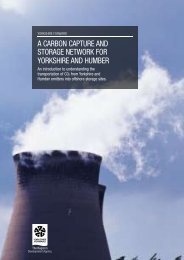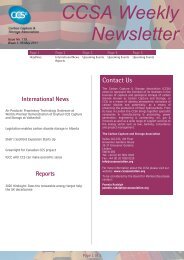Final report for One North East And NEPIC 21/12/10 - The Carbon ...
Final report for One North East And NEPIC 21/12/10 - The Carbon ...
Final report for One North East And NEPIC 21/12/10 - The Carbon ...
Create successful ePaper yourself
Turn your PDF publications into a flip-book with our unique Google optimized e-Paper software.
<strong>The</strong> case <strong>for</strong> a Tees CCS network<strong>Final</strong> ReportDrawing on the above analysis and drawing on stakeholder consultation, a range ofsensitivities <strong>for</strong> CCS deployment have been modelled <strong>for</strong> each scenario to understand theimpacts from different phasing of connections i.e. utilisation of different networks 73 .<strong>The</strong> higher the utilisation of the network, the lower the average cost per user, as fixedcosts are shared more widely. This is illustrated in Figure 11 <strong>for</strong> a „Medium‟ CCS network.Figure 11 also shows that the cost of service is highly sensitive to the discount rate (orweighted average cost of capital). Networks funded with high cost of capital are particularlysensitive to reduced utilisation (shown in Figure 11 as the position where the cost ofservice exceeds £<strong>10</strong>/t). <strong>The</strong> economic modelling shows that where networks are fundedwith a cost of capital of 5% (i.e. where public finance is likely to be the dominant source ofcapital), then an eleven year delay can be tolerated between the first and subsequentemitters joining 74 .Figure 11 Interplay of % utilisation and % discount rate on cost of service of TeesValley Medium CCS network.<strong>The</strong> full sensitivity analysis includes:Reduced utilisation (modelled as 50% of projected emissions, either becausesome sites fail to adopt CCS or adopt CCS but provide lower CO 2 supply becauseof efficiency improvements)Delayed utilisation (<strong>for</strong> example if it takes an additional five years <strong>for</strong> CCStechnology to be adopted by other sources in the Tees Valley)Delays in construction, so that this takes five years instead of three years.<strong>One</strong>rous financial obligations, <strong>for</strong> example short payback times (<strong>10</strong> years) or highweighted average cost of capital (15%).<strong>The</strong> analysis also considered potential benefits to the network economics that might arisefrom73 See Appendix II74 If the weighted average cost of capital is <strong>10</strong>% and emitters join in two waves, only four years delay can betolerated. If the cost of capital is 15%, then less than one year delay between emitters can be tolerated.28







